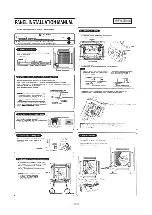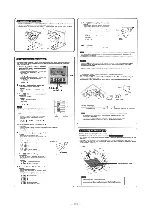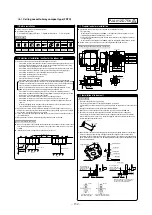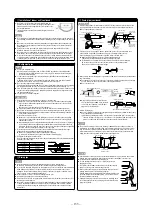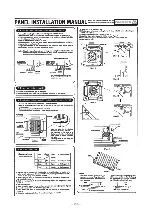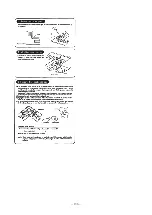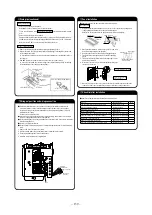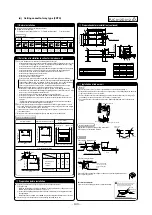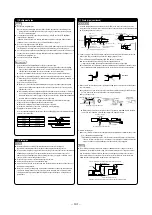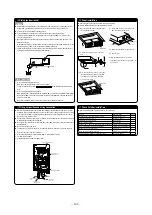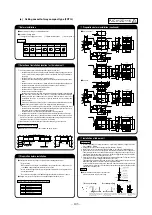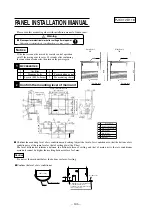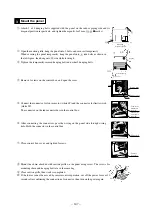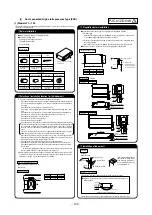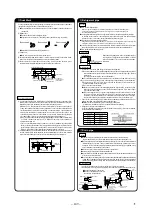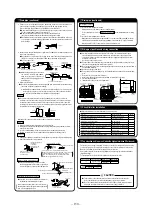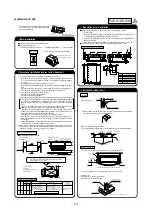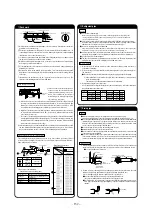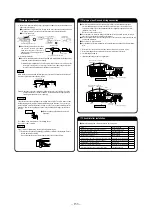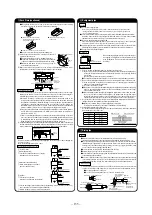
-
141
-
PJC012D012
Refrigerant pipe
Work procedure
1. Remove the fl are nut and blind fl anges on the pipe of the indoor unit.
Make sure to loosen the fl are nut with holding the nut on pipe side with a spanner and giving
torque to the nut with another spanner in order to avoid unexpected stress to the copper pipe,
and then remove them. (Gas may come out at this time, but it is not abnormal.)
z
Pay attention whether the fl are nut pops out. (as the indoor unit is sometimes pressured.)
2. Make a fl are on liquid pipe and gas pipe, and connect the refrigeration pipes on the indoor unit.
Bend the pipe with as big radius as possible and do not bend the pipe repeatedly. In addition, do
not twist and crush the pipes.
Do a fl are connection as follows:
z
Make sure to loosen the fl are nut with holding the nut on pipe side with a spanner and giving
torque to the nut with another spanner in order to avoid unexpected stress to the copper pipe,
and then remove them.
z
When fastening the fl are nut, align the refrigeration pipe with the center of fl are nut, screw the nut
for 3-4 times by hand and then tighten it by spanner with the specifi ed torque mentioned in the
table below. Make sure to hold the pipe on the indoor unit securely by a spanner when tightening
the nut in order to avoid unexpected stress on the copper pipe.
3. Cover the fl are connection part of the indoor unit with attached insulation material after a gas
leakage inspection, and tighten both ends with attached straps.
z
Make sure to insulate both gas pipes and liquid pipes completely.
Incomplete insulation may cause dew condensation or water dropping.
4. Refrigerant is charged in the outdoor unit.
As for the additional refrigerant charge for the indoor unit and piping, refer to the installation manual
attached to the outdoor unit.
Pipe diameter
Tightening torque N·m
I
6.35
14 to 18
I
9.52
34 to 42
I
12.7
49 to 61
I
15.88
68 to 82
I
19.05
100 to 120
Drain pipe
Caution
z
Install the drain pipe according to the installation manual in order to drain properly.
Imperfection in draining may cause fl ood indoors and wetting the household goods etc.
z
Do not put the drain pipe directly into the ditch where toxic gas such as sulfur, the other harmful and
infl ammable gas is generated. Toxic gas would fl ow into the room and it would cause serious
damage to user’s health and safety (some poisoning or defi ciency of oxygen). In addition, it may
cause corrosion of heat exchanger and bad smell.
z
Connect the pipe securely to avoid water leakage from the joint.
z
Insulate the pipe properly to avoid condensation drop.
z
Check if the water can fl ow out properly from both the drain outlet on the indoor unit and the end of
the drain pipe after installation.
z
Make sure to make descending slope of greater than 1/100 and do not make up-down bend and/
or trap in the midway. In addition, do not put air vent on the drain pipe. Check if water is drained
out properly from the pipe during commissioning. Also, keep suffi cient space for inspection and
maintenance.
Drain pipe (continued)
3. Make sure to make descending slope of greater than 1/100 and do not make up-down bend and/or
trap in the midway.
z
Pay attention not to give stress on the pipe on the indoor unit side, and support and fi x the pipe
as close place to the unit as possible when connecting the drain pipe.
z
Do not set up air vent.
Supporting fixture
Supporting metal
Air vent
No bump
No trap
Not touching
the water
Trapped air will
generate noises.
Insulation material
1.5m~2m
Descending slope greater than 1/100
z
When sharing a drain pipe for more than one unit, lay the main pipe 100mm below the drain
outlet of the unit. In addition, select VP-30 or bigger size for main drain pipe.
Descending slope greater than 1/100
VP-30 or bigger
As wide as possible
(about100mm)
4. Insulate the drain pipe.
z
Be sure to insulate the drain socket and rigid PVC pipe installed indoors otherwise it may cause
dew condensation and water leakage.
After drainage test implementation, cover the drain socket part with pipe cover (small size),
then use the pipe cover (big size) to cover the pipe cover (small size), clamps and part of the
drain hose, and fi x and wrap it with tapes to wrap and make joint part gapless.
Drain up
z
The position for drain pipe outlet can be raised up to 600mm above the ceiling. Use elbows for
installation to avoid obstacles inside ceiling. If the horizontal drain pipe is too long before vertical
pipe, the backfl ow of water will increase when the unit is stopped, and it may cause overfl ow of
water from the drain pan on the indoor unit. In order to avoid overfl ow, keep the horizontal pipe
length and offset of the pipe within the limit shown in the fi gure below.
Specific configurations as shown below when the drain head is raised.
Drain hose
295-325mm
Joint for VP20 (Prepare on site)
Ceiling
100mm or less
All piping work except above piping are performed in a similar normal drain piping.
Max.
600mm
Wiring-out position and wiring connection
z
Electrical installation work must be performed according to the installation manual by an electrical
installation service provider qualifi ed by a power provider of the country, and be executed according
to the technical standards and other regulations applicable to electrical installation in the country.
Be sure to use an exclusive circuit.
z
Use specifi ed cord, fasten the wiring to the terminal securely, and hold the cord securely in order not
to apply unexpected stress on the terminal.
z
Do not put both power source line and signal line on the same route. It may cause miscommunication
and malfunction.
z
Be sure to do D type earth work.
z
For the details of electrical wiring work, see attached instruction manual for electrical wiring work.
1. Remove a lid of the control box (2 screws).
2. Hold each wiring inside the unit and fasten them to terminal block securely.
3. Fix the wiring with clamps.
4. Install the removed parts back to original place.
L
N
Earth (Signal line)
Indoor power
source line
Signal side terminal block
Power source side
terminal block
Earth
Remote controller
line
Signal line
(Shielded cord)
Strap (Accessory)
Pipe cover (Accessory)
The thickness of insulation should be 20mm or more.
Check list after installation
z
Check the following items after all installation work completed.
Check if:
Expected trouble
Check
The indoor and outdoor units are fi xed securely?
Falling, vibration, noise
Inspection for leakage is done?
Insuffi cient capacity
Insulation work is properly done?
Water leakage
Water is drained properly?
Water leakage
Supply voltage is same as mentioned in the model name plate? PCB burnt out, not working at all
There is mis-wiring or mis-connection of piping?
PCB burnt out, not working at all
Earth wiring is connected properly?
Electric shock
Cable size comply with specifi ed size?
PCB burnt out, not working at all
Any obstacle blocks airfl ow on air inlet and outlet?
Insuffi cient capacity
Panel installation
z
Attach the panel on the indoor unit after electrical wiring work.
z
Refer to attached manual for panel installation for details.
Open the grille and remove the baffl e plate.
(Loosing the two screws.)
Baffle plate
Screw the two installation screws to the indoor
unit.
Detail A
Appro
x.
15mm
Hook the panel the two screws (-
), and slide
the panel approximately 10mm along the allow
in following fi gure. Screw left fi ve installation
screw to the indoor unit.
Sliding direction
Connect the connectors of louver motor and
limit switch using "opening" space.
Ceiling opening
Connector
Opening
Return the baffl e plate at its original position.
Close the grille.
Confi rm the grille fi xed with a hook securely.
* The grille may take the liberty to open if grille is not
fi xed securely.
Caution
z
Use the new refrigerant pipe.
When re-using the existing pipe system for R22 or R407C, pay attention to the following items.
x
Change the fl are nuts with the attached ones (JIS category 2), and reprocess the fl are parts.
x
Do not use thin-walled pipes.
z
Use phosphorus deoxidized copper alloy seamless pipe (C1220T specifi ed in JIS H3300) for
refrigeration pipe installation.
In addition, make sure there is no damage both inside and outside of the pipe, and no harmful
substances such as sulfur, oxide, dust or a contaminant stuck on the pipes.
z
Do not use any refrigerant other than R410A.
Using other refrigerant except R410A (R22 etc.) may degrade inside refrigeration oil. And air getting
into refrigeration circuit may cause over-pressure and resultant it may result in bursting, etc.
z
Store the copper pipes indoors and seal the both end of them until they are brazed in order to avoid
any dust, dirt or water getting into the pipe. Otherwise it will cause degradation of refrigeration oil
and compressor breakdown, etc.
z
Use special tools for R410 refrigerant.
Drain pipe (continued)
Drain test
z
After installation of drain pipe, make sure that drain system work in good condition and no water
leakage from joint and drain pan. Check if the motor sound of drain pump is normal or not.
z
Do drain test even if installation of heating season.
z
For new building cases, make sure to complete the test before hanging the ceiling.
1. Pour water of about 1000cc into the drain pan in the indoor unit by pump so as not to get the
electrical component wet.
2. Make sure that water is drained out properly and there is no water leakage from any joints of the
drain pipe at the test.
Confi rm that the water is properly drained out while the drain motor is operating. At the drain socket
(transparent), it is possible to check if the water is drained out properly.
3. Unplug the drain plug on the indoor unit to remove remaining water on the drain pan after the test,
and re-plug it. And insulate the drain pipe properly fi nally.
Drain pump operation
c
In case electrical wiring work fi nished
Drain pump can be operated by remote controller (wired).
For the operation method, refer to Operation for drain pump in the installation manual for wiring
work.
c
In case electrical wiring work not fi nished
Drain pump will run continuously when the dip switch“SW7-1” on the indoor unit PCB is turned ON,
the Connector CNB is disconnected, and then the power supply (230VAC on the terminal block
and
) is turned ON.
Make sure to turn OFF “SW7-1” and reconnect the Connector CNB after the test.
2. Prepare a joint for connecting VP-20 pipe, adhere and connect the joint to the drain hose (the end
made of rigid PVC), and adhere and connect VP-20 pipe (prepare on site).
As for drain pipe, apply VP-20 made of rigid PVC which is on the market.
z
Make sure that the adhesive will not get into the supplied drain hose.
It may cause the fl exible part broken after the adhesive is dried up and gets rigid.
z
The fl exible drain hose is intended to absorb a small difference at installation of the unit or drain
pipes. Intentional bending, expanding may cause the fl exible hose broken and water leakage.
Work procedure
1. Insert the supplied drain hose (the end made of soft PVC) to the step of the drain socket on the
indoor unit and fi x it securely with the clamp.
z
Do not apply adhesives on this end.
Pipe cover
(big) (For insulation)
(Accessory)
Joint for VP20 (Prepare on site)
Main frame
Drain socket
Clamp (Accessory)
(Adhesive must not be used)
Pipe cover (Prepare on site)
(For insulation)
VP20 (Prepare on site)
Drain socket
Slap
Drain hose
Drain hose
(Accessory)
Pipe cover (small) (For insulation) (Accessory)
Connect
Attach the hose clamp to the drain hose around 10mm from the end.
PJC012D012
Refrigerant pipe
Work procedure
1. Remove the fl are nut and blind fl anges on the pipe of the indoor unit.
Make sure to loosen the fl are nut with holding the nut on pipe side with a spanner and giving
torque to the nut with another spanner in order to avoid unexpected stress to the copper pipe,
and then remove them. (Gas may come out at this time, but it is not abnormal.)
z
Pay attention whether the fl are nut pops out. (as the indoor unit is sometimes pressured.)
2. Make a fl are on liquid pipe and gas pipe, and connect the refrigeration pipes on the indoor unit.
Bend the pipe with as big radius as possible and do not bend the pipe repeatedly. In addition, do
not twist and crush the pipes.
Do a fl are connection as follows:
z
Make sure to loosen the fl are nut with holding the nut on pipe side with a spanner and giving
torque to the nut with another spanner in order to avoid unexpected stress to the copper pipe,
and then remove them.
z
When fastening the fl are nut, align the refrigeration pipe with the center of fl are nut, screw the nut
for 3-4 times by hand and then tighten it by spanner with the specifi ed torque mentioned in the
table below. Make sure to hold the pipe on the indoor unit securely by a spanner when tightening
the nut in order to avoid unexpected stress on the copper pipe.
3. Cover the fl are connection part of the indoor unit with attached insulation material after a gas
leakage inspection, and tighten both ends with attached straps.
z
Make sure to insulate both gas pipes and liquid pipes completely.
Incomplete insulation may cause dew condensation or water dropping.
4. Refrigerant is charged in the outdoor unit.
As for the additional refrigerant charge for the indoor unit and piping, refer to the installation manual
attached to the outdoor unit.
Pipe diameter
Tightening torque N·m
I
6.35
14 to 18
I
9.52
34 to 42
I
12.7
49 to 61
I
15.88
68 to 82
I
19.05
100 to 120
Drain pipe
Caution
z
Install the drain pipe according to the installation manual in order to drain properly.
Imperfection in draining may cause fl ood indoors and wetting the household goods etc.
z
Do not put the drain pipe directly into the ditch where toxic gas such as sulfur, the other harmful and
infl ammable gas is generated. Toxic gas would fl ow into the room and it would cause serious
damage to user’s health and safety (some poisoning or defi ciency of oxygen). In addition, it may
cause corrosion of heat exchanger and bad smell.
z
Connect the pipe securely to avoid water leakage from the joint.
z
Insulate the pipe properly to avoid condensation drop.
z
Check if the water can fl ow out properly from both the drain outlet on the indoor unit and the end of
the drain pipe after installation.
z
Make sure to make descending slope of greater than 1/100 and do not make up-down bend and/
or trap in the midway. In addition, do not put air vent on the drain pipe. Check if water is drained
out properly from the pipe during commissioning. Also, keep suffi cient space for inspection and
maintenance.
Drain pipe (continued)
3. Make sure to make descending slope of greater than 1/100 and do not make up-down bend and/or
trap in the midway.
z
Pay attention not to give stress on the pipe on the indoor unit side, and support and fi x the pipe
as close place to the unit as possible when connecting the drain pipe.
z
Do not set up air vent.
Supporting fixture
Supporting metal
Air vent
No bump
No trap
Not touching
the water
Trapped air will
generate noises.
Insulation material
1.5m~2m
Descending slope greater than 1/100
z
When sharing a drain pipe for more than one unit, lay the main pipe 100mm below the drain
outlet of the unit. In addition, select VP-30 or bigger size for main drain pipe.
Descending slope greater than 1/100
VP-30 or bigger
As wide as possible
(about100mm)
4. Insulate the drain pipe.
z
Be sure to insulate the drain socket and rigid PVC pipe installed indoors otherwise it may cause
dew condensation and water leakage.
After drainage test implementation, cover the drain socket part with pipe cover (small size),
then use the pipe cover (big size) to cover the pipe cover (small size), clamps and part of the
drain hose, and fi x and wrap it with tapes to wrap and make joint part gapless.
Drain up
z
The position for drain pipe outlet can be raised up to 600mm above the ceiling. Use elbows for
installation to avoid obstacles inside ceiling. If the horizontal drain pipe is too long before vertical
pipe, the backfl ow of water will increase when the unit is stopped, and it may cause overfl ow of
water from the drain pan on the indoor unit. In order to avoid overfl ow, keep the horizontal pipe
length and offset of the pipe within the limit shown in the fi gure below.
Specific configurations as shown below when the drain head is raised.
Drain hose
295-325mm
Joint for VP20 (Prepare on site)
Ceiling
100mm or less
All piping work except above piping are performed in a similar normal drain piping.
Max.
600mm
Wiring-out position and wiring connection
z
Electrical installation work must be performed according to the installation manual by an electrical
installation service provider qualifi ed by a power provider of the country, and be executed according
to the technical standards and other regulations applicable to electrical installation in the country.
Be sure to use an exclusive circuit.
z
Use specifi ed cord, fasten the wiring to the terminal securely, and hold the cord securely in order not
to apply unexpected stress on the terminal.
z
Do not put both power source line and signal line on the same route. It may cause miscommunication
and malfunction.
z
Be sure to do D type earth work.
z
For the details of electrical wiring work, see attached instruction manual for electrical wiring work.
1. Remove a lid of the control box (2 screws).
2. Hold each wiring inside the unit and fasten them to terminal block securely.
3. Fix the wiring with clamps.
4. Install the removed parts back to original place.
L
N
Earth (Signal line)
Indoor power
source line
Signal side terminal block
Power source side
terminal block
Earth
Remote controller
line
Signal line
(Shielded cord)
Strap (Accessory)
Pipe cover (Accessory)
The thickness of insulation should be 20mm or more.
Check list after installation
z
Check the following items after all installation work completed.
Check if:
Expected trouble
Check
The indoor and outdoor units are fi xed securely?
Falling, vibration, noise
Inspection for leakage is done?
Insuffi cient capacity
Insulation work is properly done?
Water leakage
Water is drained properly?
Water leakage
Supply voltage is same as mentioned in the model name plate? PCB burnt out, not working at all
There is mis-wiring or mis-connection of piping?
PCB burnt out, not working at all
Earth wiring is connected properly?
Electric shock
Cable size comply with specifi ed size?
PCB burnt out, not working at all
Any obstacle blocks airfl ow on air inlet and outlet?
Insuffi cient capacity
Panel installation
z
Attach the panel on the indoor unit after electrical wiring work.
z
Refer to attached manual for panel installation for details.
Open the grille and remove the baffl e plate.
(Loosing the two screws.)
Baffle plate
Screw the two installation screws to the indoor
unit.
Detail A
Appro
x. 15mm
Hook the panel the two screws (-
), and slide
the panel approximately 10mm along the allow
in following fi gure. Screw left fi ve installation
screw to the indoor unit.
Sliding direction
Connect the connectors of louver motor and
limit switch using "opening" space.
Ceiling opening
Connector
Opening
Return the baffl e plate at its original position.
Close the grille.
Confi rm the grille fi xed with a hook securely.
* The grille may take the liberty to open if grille is not
fi xed securely.
Caution
z
Use the new refrigerant pipe.
When re-using the existing pipe system for R22 or R407C, pay attention to the following items.
x
Change the fl are nuts with the attached ones (JIS category 2), and reprocess the fl are parts.
x
Do not use thin-walled pipes.
z
Use phosphorus deoxidized copper alloy seamless pipe (C1220T specifi ed in JIS H3300) for
refrigeration pipe installation.
In addition, make sure there is no damage both inside and outside of the pipe, and no harmful
substances such as sulfur, oxide, dust or a contaminant stuck on the pipes.
z
Do not use any refrigerant other than R410A.
Using other refrigerant except R410A (R22 etc.) may degrade inside refrigeration oil. And air getting
into refrigeration circuit may cause over-pressure and resultant it may result in bursting, etc.
z
Store the copper pipes indoors and seal the both end of them until they are brazed in order to avoid
any dust, dirt or water getting into the pipe. Otherwise it will cause degradation of refrigeration oil
and compressor breakdown, etc.
z
Use special tools for R410 refrigerant.
Drain pipe (continued)
Drain test
z
After installation of drain pipe, make sure that drain system work in good condition and no water
leakage from joint and drain pan. Check if the motor sound of drain pump is normal or not.
z
Do drain test even if installation of heating season.
z
For new building cases, make sure to complete the test before hanging the ceiling.
1. Pour water of about 1000cc into the drain pan in the indoor unit by pump so as not to get the
electrical component wet.
2. Make sure that water is drained out properly and there is no water leakage from any joints of the
drain pipe at the test.
Confi rm that the water is properly drained out while the drain motor is operating. At the drain socket
(transparent), it is possible to check if the water is drained out properly.
3. Unplug the drain plug on the indoor unit to remove remaining water on the drain pan after the test,
and re-plug it. And insulate the drain pipe properly fi nally.
Drain pump operation
c
In case electrical wiring work fi nished
Drain pump can be operated by remote controller (wired).
For the operation method, refer to Operation for drain pump in the installation manual for wiring
work.
c
In case electrical wiring work not fi nished
Drain pump will run continuously when the dip switch“SW7-1” on the indoor unit PCB is turned ON,
the Connector CNB is disconnected, and then the power supply (230VAC on the terminal block
and
) is turned ON.
Make sure to turn OFF “SW7-1” and reconnect the Connector CNB after the test.
2. Prepare a joint for connecting VP-20 pipe, adhere and connect the joint to the drain hose (the end
made of rigid PVC), and adhere and connect VP-20 pipe (prepare on site).
As for drain pipe, apply VP-20 made of rigid PVC which is on the market.
z
Make sure that the adhesive will not get into the supplied drain hose.
It may cause the fl exible part broken after the adhesive is dried up and gets rigid.
z
The fl exible drain hose is intended to absorb a small difference at installation of the unit or drain
pipes. Intentional bending, expanding may cause the fl exible hose broken and water leakage.
Work procedure
1. Insert the supplied drain hose (the end made of soft PVC) to the step of the drain socket on the
indoor unit and fi x it securely with the clamp.
z
Do not apply adhesives on this end.
Pipe cover
(big) (For insulation)
(Accessory)
Joint for VP20 (Prepare on site)
Main frame
Drain socket
Clamp (Accessory)
(Adhesive must not be used)
Pipe cover (Prepare on site)
(For insulation)
VP20 (Prepare on site)
Drain socket
Slap
Drain hose
Drain hose
(Accessory)
Pipe cover (small) (For insulation) (Accessory)
Connect
Fasten the screw securely
Hose clamp
Drain hose
Drain socket
Metal plate
10mm
Over 20mm
Summary of Contents for 112KXE6
Page 105: ... 101 Model FDC335KXE6 A PCB003Z035 shows local wining ...
Page 134: ... 130 PJF012D003 ...
Page 135: ... 131 ...
Page 139: ... 135 PJA012D751 b ...
Page 140: ... 136 ...
Page 206: ... 202 2 model type DIS model type HEAD ...
Page 207: ... 203 2 2 ...
Page 208: ... 204 2 2 2 2 2 ...




